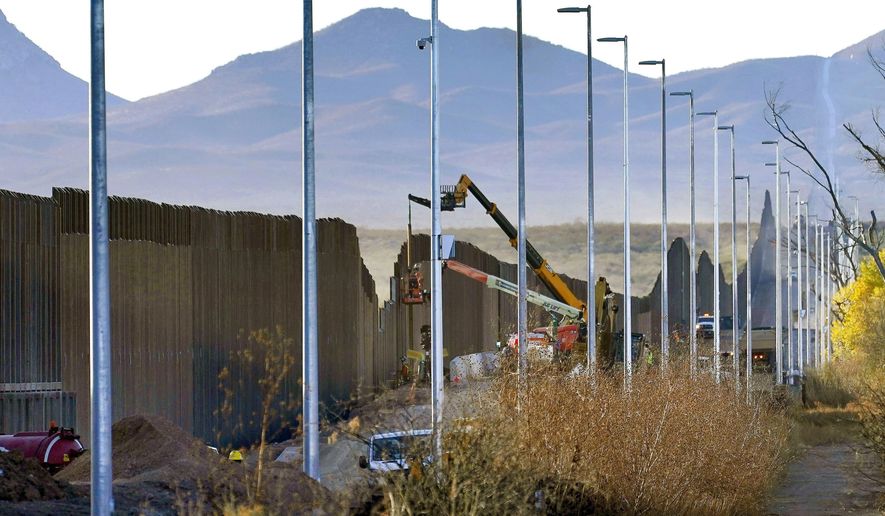Department of Homeland Security Secretary Alejandro Mayorkas told department employees he may restart border wall construction to plug what he called “gaps” in the current barrier.
In a conversation with Immigration and Customs Enforcement employees last week Mr. Mayorkas was asked about his plans for the wall and he said that while President Biden has canceled the border emergency and halted Pentagon money flowing to the wall, “that leaves room to make decisions” on finishing some “gaps in the wall.”
Mr. Mayorkas, according to notes of the ICE session reviewed by The Washington Times, said Customs and Border Protection, which oversees the wall, has submitted a plan for what it wants to see happen moving forward.
“It’s not a single answer to a single question. There are different projects that the chief of the Border Patrol has presented and the acting commissioner of CBP presented to me,” the secretary said.
“The president has communicated quite clearly his decision that the emergency that triggered the devotion of DOD funds to the construction of the border wall is ended. But that leaves room to make decisions as the administration, as part of the administration, in particular areas of the wall that need renovation, particular projects that need to be finished,” he said.
He said those parts include “gaps,” “gates,” and areas “where the wall has been completed but the technology has not been implemented.”
CBP did not return a message seeking comment on what was submitted to Mr. Mayorkas.
Mark Morgan, who served as acting commissioner of CBP under President Trump, said Mr. Mayorkas’s comments were “more spin and misdirection.”
He said CBP has always given the administration options for how to proceed on the wall.
Mr. Trump left office with about 460 miles of border wall completed, funded by a mixture of money Congress specifically approved and money Mr. Trump siphoned from Pentagon accounts after declaring a national emergency.
Most of that construction came where a barrier already existed, replacing outdated designs or vehicle barriers that did nothing to stop people on foot.
The new wall is more than just the steel slats. Officials describe it as a system, one that includes technology to allow agents to detect incursions and high-speed roads to allow them to reach trouble spots faster so that agents can interdict anyone who does make it over.
That a question about the wall came from employees at U.S. Immigration and Customs Enforcement, which handles interior enforcement and deportation rather than border matters, shows just how deeply the wall has penetrated the psychology of Homeland Security.
It’s sparked fierce devotees — including Border Patrol agents themselves — and rabid opponents.
But with Mr. Trump out of office, the public is swinging back toward the wall, with a recent poll conducted for the Senate Opportunity Fund showing 53% now favor construction.
President Biden, however, remains an opponent, despite voting as a senator for 700 miles of border fencing and being part of the Obama administration that constructed more than 100 of those miles.
He vowed last year that he wouldn’t build “one more foot” of wall and on Inauguration Day he imposed a full stop on construction.
The Washington Times reported last month that the halt left holes in the wall in Cochise County, Arizona, where miles of road were already finished but the wall was not.
The county sheriff said smugglers were using the road as their own highway, helping them get their illegal cargo, whether people or drugs, deeper into the country faster.
“We just built roads for the cartels,” Sheriff Mark Dannels said.
Mr. Biden, when he announced his wall pause, gave Homeland Security the task of figuring out how to proceed, within legal limits.
Those legal questions may force Mr. Mayorkas to build more wall. The Washington Times reported in January that experts on congressional and presidential powers said Mr. Biden’s halt likely violated what’s known as the Impoundment Control Act.
Under that law, when Congress flexes its power of the purse to allocate money for a purpose, the administration must carry it out. The only exceptions are when there are questions of efficiency, or when the president officially submits a revocation request. Policy disagreements are not sufficient reason.
Congress over the last four years has allocated $1.375 billion each year for the wall, including in this current fiscal year.
Mr. Biden has not submitted a request to rescind that money.
Congressional Republicans have asked the Government Accountability Office to review the pause and rule on whether it is legal. The GAO has accepted the request, according to lawmakers.
Republicans compare Mr. Biden’s pause to Mr. Trump, whom Democrats accused of breaking the law in 2019 by freezing security assistance money intended for Ukraine. The GAO issued a ruling early last year finding the Ukraine freeze illegal.
Mr. Trump has been a cheerleader for his signature project, calling on his successor to finish construction.
But Mr. Trump has also said that the wall is “almost complete.”
“We just had to fix little sections,” he told Fox News last month.
In fact, Customs and Border Protection said in early January, still during the Trump administration, that it had finalized plans to build about 300 more miles, and much of that was already under contract.
Mr. Trump himself has suggested contractors will have to be paid out over wall that was already signed off on, but no longer will be built.
Mr. Morgan, the former CBP chief, has estimated those costs could reach billions of dollars.
• Stephen Dinan can be reached at sdinan@washingtontimes.com.




Please read our comment policy before commenting.